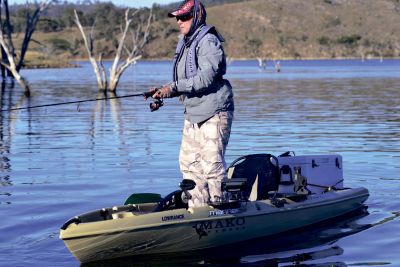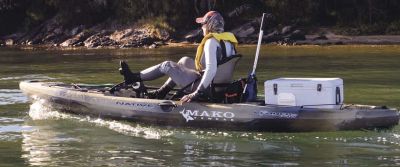 Presented from Issue 114, February 2015 and 115 April 2015
Presented from Issue 114, February 2015 and 115 April 2015
Have you been exercising your grey matter, thinking about getting into a kayak for some fishing fun? There’s a lot to think about, and the thinking doesn’t stop once you’ve carefully chosen your vessel. You’ll also need to put a lot of thought into setting it up for action, as Jo Starling explains.
Being a relative newcomer to the world of ‘yak fishing, I still climb the sport’s steep learning curve each and every time I go out. That’s one of the many great things about fishing… it’s just like a braided river; regardless of how well you think you know it, there’s always another ‘stream’ to explore!
You might assume that stepping into a kayak for a fish will not be a big stretch from your everyday fishing activities, but give it a go and you will soon realise how very different it is. Of course, the fishing nitty-gritty won’t change.
Your lure, bait and tackle choices still come from the same knowledge bank you take out with you on each and every trip… that’s not what I’m talking about.
This is not an article about hooking up to a fish. It’s an article about successfully getting your hook in front of a fish, without tipping yourself out of your kayak in the process!
I’ve discovered that a kayak is the ultimate critic of your organisational prowess. Get it right and she’s a kind and benevolent mentor, rewarding you with ease, peace, pace and even fish. Get it wrong and you soon find yourself in a tangle, bested by the beastly biatch with an uncompromising mantra—one we’ve all heard before: Prior Preparation and Planning Prevents Poor Performance.
That’s right, folks. Whilst all forms of fishing require planning and preparation, in my opinion, kayak fishing takes the proverbial cake. Why? The answer is simple… limited space.
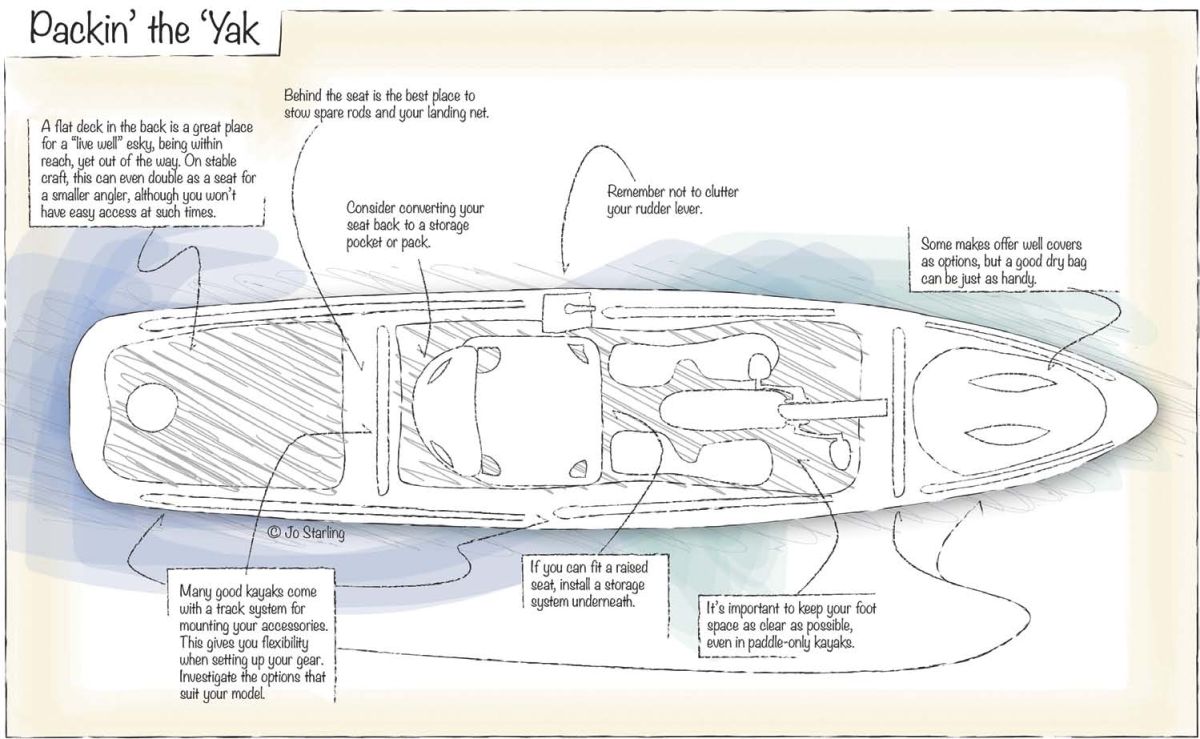
The author’s logical layout has developed
over months of trial and error.
Click on the plan for a larger view
At risk of sounding like a new-age hippie, the truth is that successful outings in the kayak require you to be much more ‘mindful’ and ‘present’ than when boat or shore-based fishing. To my mind, it’s similar to the awareness you need for line control when fly fishing, only with even more tangle-hazards!
You will launch for each trip with the same hopes and dreams that you take aboard any other vessel; only in a kayak you have limited deck space. This is much more easily managed if you are intending to troll, but if (like me) you’re a castaholic, it’s a whole new game in an entirely different arena!
No room to can-can
Your kayak workspace is tight, even in the generous models purpose-designed with fishing in mind. Staying onboard and safe comes down to being organised, as the standing space you do have will barely be enough for your two feet… it’s certainly not a dance floor!
Along with your tootsies, you’ll have to stow at least your rod or rods, landing net, tackle and paddle, not to mention all those other vital little odds and sods. These all need to be strategically located for easy access—and careful planning is required as a poorly placed spare rod or net handle is just waiting to mess you up, especially in windy conditions! Such tangles can prove not only frustrating, but also damaging to rod tips, etc., if you don’t realise your predicament in time.
The likelihood is that you’ll reconfigure your new kayak several times before you find the set-up that works best for you. I’m still tweaking mine, but I reckon I’m getting pretty close now. Here’s a quick overview of my set-up routine and storage configuration for my Slayer Propel 13… you may well choose a different ‘yak, but hopefully you’ll find this thought process useful … and a warning: pimping your ‘yak is very addictive!
Streamline a simple, systemic set-up
Your primary concerns need to be maximum functionality from minimal gear and convenient, easy reach accessibility.
As I like to release any fish that I’m not going to eat fresh, having a live well is important to me. It enables me to keep my fish alive and well whilst I reorganise my kayak for photos. Some kayaks come with optional keep tanks, but I haven’t yet seen one that allows for a quality fish to be kept alive for successful release. For this reason, I recommend finding yourself a low profile icebox that will fit snugly in the rear of your kayak.
My icebox plays a pivotal role in my kayak forays, as it is so much more than my live well… it’s the storage and transportation container for all my peripherals— sounder, batteries, tools, tackle, rod holders, bailer—you name it, I keep it packed carefully (and dry, of course) in the esky. As your kayak is likely to require you to do your set-up on the water’s edge, this system makes lugging all your gear from car to kayak a lot easier! Plus, if you’re diligent, you’ll always know that you’ve got everything you need.
Once you’re set up, you simply plug in the esky bung, strap it into place and scoop in some water to start you off (for stability and speed I don’t fill it to more than 5 or 6cm deep to start with, but it’s always good to have a little water ready for when you need it… it’s that “prior preparation and planning” thing again).
Speaking of planning ahead, lanyards are a must-have item! When a big fish is on, your cool, calm and collected demeanour can evaporate quickly and it’s easy to find yourself as frenetic as a whirlwind trapped in a shoebox. It’s common to shove things out of the way in the heat of the moment. Lanyards on nets, waterproof bags, etc. are a very good idea… and therefore should form part of your esky pack.
So, like every good Aussie—remember your esky! Make it an integral part of your set-up and storage plan.
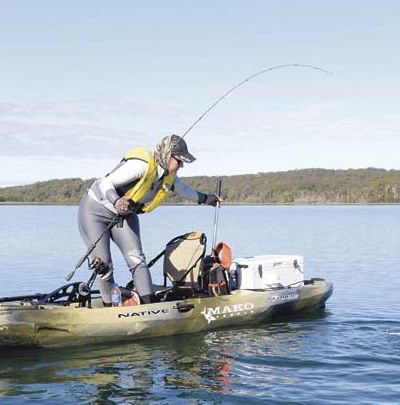 |
| It’s at the crucial moment of landing your fish that poor planning will become obvious. A little forethought goes a long way. |
Focus on landing your fish
Now let’s look at locating everything in your ‘yak. As we’ve covered, you’ll probably adjust your thinking several times before you settle on your final configuration. I’m fairly confident in saying that most of your inspiration for improvement will come when you’re working on landing your fish. It’s at this point that any flaws the efficiency of your workspace will boast their presence. So, if you keep the needs of this in the forefront of your mind whilst planning, you’ll achieve a better set-up faster.
Finding spots for all your gear really comes down to your needs and preferences. I like my sounder to be on my dominant hand side, for example, as I tend to tweak it a bit. Despite what side you choose, you should be able to read and reach your sounder while seated… that’s a no-brainer.
Any spot on your ‘yak that is not active standing and/ or fishing space should be utilised for storage. Consider turning your seat back into a pocket/pack for extra tools, spools of line, additional tackle, etc. My ‘yak boasts a “first class” seat, which allows me to store tackle trays and tools underneath and out of the way. It’s really important to ensure you are able to keep your scissors, pliers and lip grips (if you use them) readily accessible, so think carefully about what goes where.
Most kayaks will have a storage zone in the bow. This is a great place to keep your dry pack, food and drink, (and, in fact, anything that you are only likely to need occasionally) as reaching gear here whilst in open water can be tricky.
Once you have the placement of all your equipment sorted out, you should consider the “how” of the placement. I learned from bitter experience that battling to free your landing net whilst simultaneously fighting a fish will only result in tears… one battle at a time folks! Make sure that you resolve your “how” in such a way that your gear is secure enough not to become flotsam, but not so secure that you can’t easily loose it when needed.
Spare rods and nets are best secured behind your seat, with enough space that you can stand and cast without entanglement. This may seem obvious, but it’s worth stating in case your holders require drilling… that’s something you don’t want to get wrong.
In the interest of less clutter, I’ve chosen a paddle that doubles as a fish measurer... That’s one less thing I have to carry! I stow it out of the way as I use a pedal kayak and so don’t need it much, but it is within easy reach for measuring and those occasions when I do need a paddle. If you choose to go the same way, always make sure that you stow it with the zero mark closest to you, allowing for quick and trouble-free measuring… it’s all those ‘Ps’ again!
If you are one of the many ‘yakkers who choose a paddle only kayak, then I can’t stress strongly enough the importance of your paddle placement and management. Seriously consider some form of lanyard… the worst possible outcome is losing your only form of propulsion! Regardless of what make or model you choose, fishing from a ‘yak will force you to streamline everything, from your tackle to your movements. It will demand a simplified, yet well-honed approach if you are to reap rewards, which in essence is what makes it so much the sweeter when you get it right.
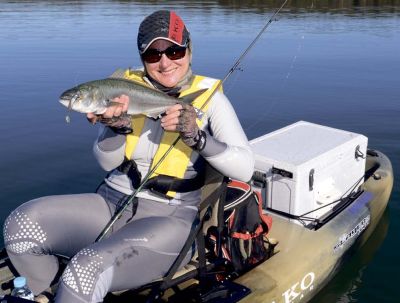 |
| Learning to fish from a kayak is a great adventure and every success is adrenalin charged. This salmon was the author’s first fish landed from her kayak. |
Part 2 - Dodging a dunking
Whilst kayak fishing itself may not be difficult, there are some hidden traps for newbies. In this article, Jo Starling explores some of the pitfalls awaiting the unwary, in an effort to make sure that’s not you! What could be simpler than popping your butt in a kayak and going out for a fish? They’re more streamlined and high-tech than the canoes of old—and our human forebears traversed vast bodies of water in those basic craft. How hard can kayak fishing be, right? …Well, as it turns out, perhaps harder than some people think. I am on a quest to become a proficient kayak fisher. So far, I’ve focused on enclosed waterways; lakes, estuaries and rivers. I haven’t yet braved a bar crossing, nor even open ocean water. I have put my beloved Native
Watercraft into some pretty intense inland situations, however, which has proven that I really must learn to walk before I try to put those big runs on the board. Being a novice kayak fisher is quite a fun thing to be. As with any new endeavour, there’s far more adrenalin involved in the skill acquisition phase than there is when you’re an old hand. That adrenalin makes every outing so much more of an adventure than those you embark once you’ve been doing it for a while.
Let me preface this article by admitting that I’m a very proud person. It’s a big part of why I like to be in control of my circumstances—embarrassment and humiliation are not an option I like to consider! I’m not naïve enough to claim ownership of this, nor do I believe I walk this path alone. That’s why I want to share some revelations here, just in case you (like me) have discovered a hankering to fish from a kayak. Hopefully, one or all of these tips will save a few red faces or, at the very least, some frustration.
“Oooooh” moments
There’s a moment just before ‘it’ all goes to pot that time freezes and your mind says “uh oh”. Anyone sitting on the sidelines will throw you a tortured cringe before turning away and muttering a painful “oooooh”. They quietly think to themselves, “I’m so glad that wasn’t me!”… then, depending on circumstances, a cacophony of guffaws often follows. Whilst I am capable of laughing off embarrassment, I do prefer to avoid it. And, of course, there are times when things going wrong are no laughing matter!
Being a newbie in a kayak will present many an opportunity to embarrass yourself, so let’s get them out on the table and expose where these wicked “tip hazards” are… and how to handle them. It goes without saying that a well-balanced kayak is going to make your life a lot easier than one that has gear stowed haphazardly. Not only is it less likely to “buck you off”, but it will be more efficient through the water. So always take the time to make sure weight is evenly balanced and your kayak doesn’t list in the water.
“Cyclists of the sea!”
Have you ever heard this term? Taken on face value, it might seem particularly applicable to me, being that I’m the proud owner of a Native Watercraft kayak that uses pedals in a traditional bicycle motion to power a propeller. The term is usually applied with more than a hint of sarcasm and derogation, however, and refers to the tendency of kayakers to feel that they have greater rights on the waters than boaties.
I have a more balanced perspective, given that I now have a foot in each camp. Maritime regulations require that motorised vessels remain set distances from kayaks, which is a good thing. Whilst I have experienced frustration when boat drivers choose to ignore this rule, I’ve been equally annoyed at kayakers who choose to paddle up the middle of a river, forcing deeper hulled vessels to take the shallow track. I think this sort of behaviour is where the derogatory mantle in discussion came from—and I hope I can stop you from assuming it!
I’ve also seen evidence that, because the mandate to stay clear of kayakers exists, kayakers delegate the responsibility of their safety in relation to boats to the boat driver. This is just plain stupid! At the end of the day, the buck stops with you. You simply MUST remain vigilant and retain responsibility for your own safety, regardless of where the law sits. You may not get a second chance.
Avoiding a public dunking
On any public holiday, wakes can criss-cross in such confusion that you can have moments that feel like you’re paddling in a washing machine! This shouldn’t be a drama at all if you’re seated and have your gear distributed evenly, but if you’re someone who likes to stand and fish, like myself, then you really need to develop a sixth sense about what the water around you is doing.
Whilst conditions on a public holiday are an extreme example, the waterways need to be shared safely on any given day. I believe strongly that a kayaker should be aware of their surroundings and keep a wary distance of other vessels at all times, just as those vessels are obliged to reciprocate.
Swallowed in a moment
It’s perfectly normal to become completely absorbed in your fishing. It can happen to me even when I’m sharing a casting deck with others. Naturally, this is a potential hazard for ‘yakkers—out there, you can become “one” with your kayak, propelling yourself to where you need to be, standing or sitting that much closer to the water—it’s very easy to become consumed in the moment.
Losing yourself like this is a pretty good way to risk embarrassment. If you’re drift fishing, for example, getting knocked about by an unnoticed wake, running into shallows, or worse… running into disparaging comments as you drift absent-mindedly towards an anchored vessel, are all great ways to bring on the blush!
Similarly, we should recognise that motorboat users are just as passionate about their particular pastime, so they too might suffer momentary absorption—especially if they’re towing a skier, wake-boarder or other thrill- seeking passenger. Whilst they must have a spotter, it’s fair to say that they will occasionally look over their shoulder to check on proceedings.
Given that you, in your kayak, have a very low profile, you might be difficult to see (especially if, like me, you’re working on remaining as stealthy as possible and are therefore decked out in camo!)… Let alone when a driver is at high speed and facilitating an adrenalin rush for a mate! Whilst the boat is legally required to give you a respectful berth, remember that their route may already be planned before you paddle/pedal into the arena—take responsibility for that wide berth yourself.
Of course—in such a situation—wakes are likely to be a rockin’ inclusion to your day and in this case, not in a good sense. As someone who prefers to cast and generally fish from a standing position, I can assure you that it pays to take note when a wake boarder flies by!
Flow of information
Learning to read the water will help you avoid all manner of obstacles—such as submerged logs or rocks that are close enough to the surface to cause you trouble and shallow reaches— well before you get to them.
Pressure waves will form up-current of even the smallest fixed object that hides just beneath the surface. Similarly, water running over shallower ground will form into lots of smaller, riffly waves, creating a visibly different patch of water to the deeper channels. Keep your eyes open for these indicators and steer clear.
Then, there’s the times when you get to a river and find it flowing a lot harder than you’d like. You really need to think very carefully about whether or not it is safe and responsible to launch your kayak in fast flowing water. Only recently, this happened to me. It was on the Murrumbidgee River near Wagga and I can honestly say that if I ran any kayak other than my Native Watercraft, my day would have turned out quite differently.
The Propel unit that powers my kayak allows me to reverse and turn decisively. These two capabilities dominated my purchase decision, but I was only considering the fishing benefits. The Murrumbidgee taught me that these are very valid safety considerations as well! Let me explain…
The swirling current of a rising or rushing river is made up of powerful rips and slower eddies. The seams between these two forces can grip your ‘yak and take over your steering. This is part of the challenge that keeps white water kayakers going back again and again. It’s not much fun when you’re just trying to navigate to a suitable spot for a fish, though!
In any vessel, motorised or not, your steering relies on your vessel having enough power to either travel faster or slower than the flow of the water you’re pushing through. Any rudder is rendered useless if it is travelling at the same speed as the water. So, if you can’t travel faster than the water speed (or won’t to due to safety considerations), then your steerage will depend on you being able to slow yourself—which of course means your steering principles reverse. Not having this ability puts you in a very vulnerable and dangerous position.
During my recent fishing defeat at the hands of the ‘Bidgee, I found that I spent approximately 70 per cent of my time pedalling in reverse… and that was just to maintain steerage when going with the current! I discovered that, whilst pedalling forwards resulted in a total loss of steerage, pedalling backwards enabled me to correct my direction whilst still “going with the flow”. It was probably the biggest “a-ha” moment I’ve had on a kayak to date—and something well worth considering if you are thinking about kayaking big rivers. Those mid-water trees are stubborn and can suck you in like a siren with a tractor beam if you don’t have the power to resist!
Whilst I don’t recommend any kayaker put their ‘yak into a flooding torrent or dangerous river, circumstances can change when you are on the water. I’ve launched in the lake near my house at slack water, only to find that the return trip home was with the sucking and boiling current of a big tide. Similarly, any river that hosts a dam can rise rapidly without warning, if the authorities open the pipes.
Of course, a paddle kayak will also negotiate currents well, with backwards paddling and by cutting across the current... but that’s a whole different level of fitness to mine! My arms were made for casting.
The over-arching piece of advice here is to remain vigilant and (as the trendies like to say) “in the moment”. That will help you stay “in the ‘yak” as well!
Each time I sit my butt on my Slayer seat, my mind wonders what the day will throw at me. Will I succeed in my mission of a sneaky, stealthy fish and come home triumphant? Or will the water be my teacher once more? If there’s one thing that’s been hammered home already, it’s the fact that there is so much I have yet to learn—and the lectures are never boring!
Jo Starling
A recent outing shows the author’s evolving set-
up: landing net upright behind seat, complete with
lanyard; fish-measuring paddle within reach, but
stowed to the bow to make room for more frequently
used items; packs for tools are behind the seat…
a-ha! Time to investigate behind-seat storage.
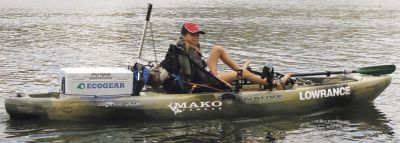
Success! After the celebrations are over, it’s
imperative to take the time to re-stow your
gear so that you’re ready for the next hook-up.
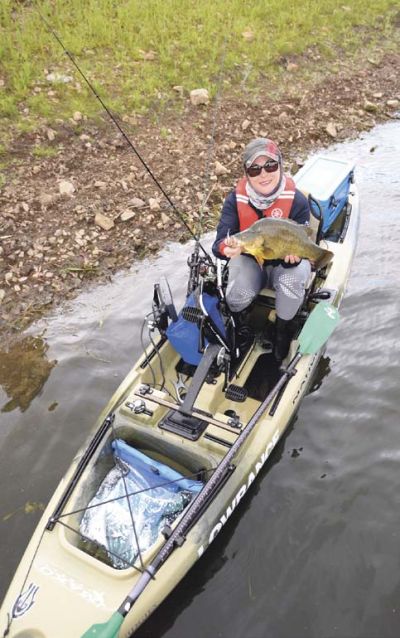
“Lost In A Moment”. It’s easy to forget to watch where you’re
going when you’re focusing on your lure and drift fishing.
